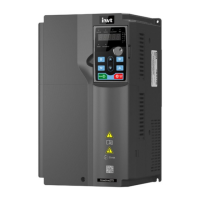Goodrive270 series VFD for fan and pump Basic operation guidelines
-126-
until difference disappears. The integral regulator can be used to eliminate static difference. However,
too large regulation may lead to repetitive overshoot, which will cause system instability and
oscillation. The feature of oscillation caused by strong integral effect is that the feedback signal
fluctuates up and down based on the reference variable, and fluctuation range increases gradually
until oscillation occurs. The integral time parameter is generally regulated gradually from large to
small until the stabilized system speed fulfills the requirement.
Differential time (Td): When the difference between feedback and reference changes, there is output
of the regulating variable that is proportional to the difference variation rate, and this regulating
variable is only related to the direction and magnitude of the difference change rather than the
direction and magnitude of the difference itself. Differential control is used to control the feedback
signal variation based on the change trend. Exercise caution before using the differential regulator
since it may enlarge the system interferences, especially those with high change frequency.
When frequency command selection (P00.06, P00. 07) is 7, or channel of voltage setup (P04.27) is 6,
the running mode of VFD is process PID control.
5.5.15.1 General procedures for PID parameter setup
1. Determine proportional gain P.
When determining proportional gain P, first, remove the integral term and derivative term of PID
by making Ti=0 and Td=0 (see PID parameter setup for details), thus turning PID into pure
proportional control. Set the input to 60%–70% of the max. allowable value, and increase
proportional gain P gradually from 0 until system oscillation occurred, and then in turn, decrease
proportional gain P gradually from current value until system oscillation disappears, record the
proportional gain P at this point and set the proportional gain P of PID to 60%–70% of current
value. This is the entire commissioning procedure of proportional gain P.
2. Determine integral time Ti.
After proportional gain P is determined, set the initial value of integral time Ti to a large value, and
decrease Ti gradually until system oscillation occurs. Then in reverse, increase Ti until system
oscillation disappears. Record the value of Ti at this point. Set the integral time constant Ti of PID
to 150%–180% of this value. This is the commissioning procedure of integral time constant Ti.
3. Determine derivative time Td.
The differential time Td is generally set to 0.
If you need to set Td to another value, the setting method is similar to that for P and Ti, namely,
set Td to 30% of the value when there is no oscillation.
4. Empty system load, perform load-carrying joint debugging, and then adjust PID parameters
until fulfilling the requirement.
5.5.15.2 How to fine-tune PID
After setting the parameters controlled by PID, you can adjust these parameters by the following
means.

